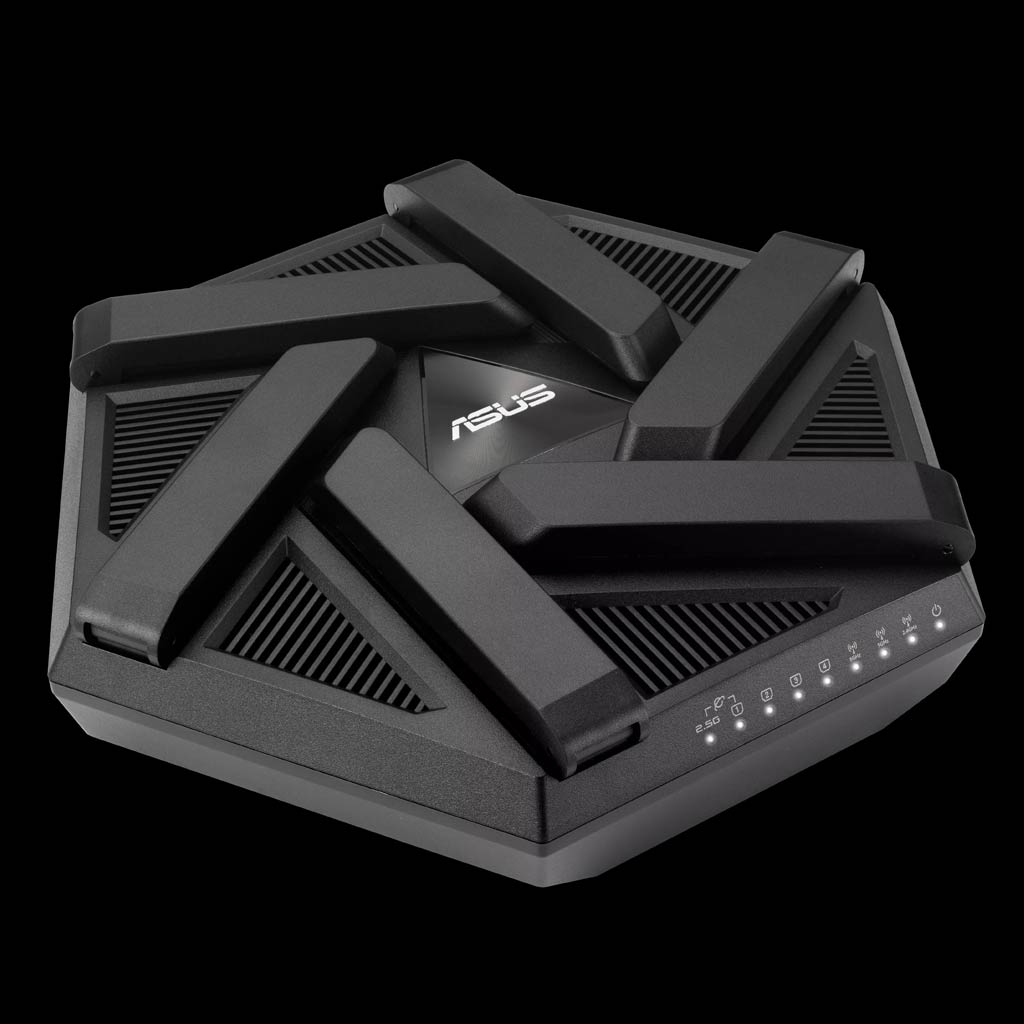In late September 2022, Asus quietly released the RT-AXE7800 router — its fifth Wi-Fi 6E broadcaster after the GT-AXE11000, ZenWiFi ET8, GT-AXE16000, and ZenWiFi Pro ET12.
Judging from the name, the new hardware seems to be another mundane Wi-Fi 6E router of a lower tier than the GT-AXE11000. But looking at the design, you’ll note that it’s anything but ordinary.
As the new router is now available in the US, this quick preview will fill you in on what to expect while waiting for my in-depth review.
Right off the bat, my take is that the RT-AXE7800 is Asus’s answer to Netgear’s similarly-specced RAXE300.

Asus RT-AXE7800: The Netgear RAXE300’s good run for its money
The RT-AXE7800 and the RAXE300 are two eye-catching Wi-Fi routers. One looks like a spaceship, and the other, well, a dead spider, but in a cool way.
They represent Asus and Netgear, respectively, in designs and Wi-Fi approaches. That said, for the most part, the RT-AXE7800 shares the good and the bad of the RAXE300. And then, it has a bit more. Let’s check their hardware specs.
Asus RT-AXE7800 vs Netgear RAXE300: Hardware specifications
 |
 |
|
| Asus AXE7800 Tri-band Wi-Fi 6E Router | Netgear Nighthawk 8-Stream AXE7800 Tri-Band Wi-Fi 6E Router |
|
| Model | Asus RT-AXE7800 | Netgear RAXE300 |
| Wi-Fi Technology | Tri-Band AXE7800 | Tri-Band AXE7800 |
| First Band | 2.4GHz 2×2 Wi-Fi 6 Up to 574Mbps (20/40MHz) |
2.4GHz 2×2 Wi-Fi 6 Up to 574Mbps (20/40MHz) |
| Second Band | 5GHz 4×4 Wi-Fi 6 Up to 4804Mbps (20/40/80/160MHz) |
5GHz 4×4 Wi-Fi 6 Up to 4804Mbps (20/40/80/160MHz) |
| Third Band | 6GHz 2×2 Wi-Fi 6E Up to 2402Mbps (20/40/80/160MHz) |
6GHz 2×2 Wi-Fi 6E Up to 2402Mbps (20/40/80/160MHz) |
| Backward Compatibility | 802.11a/b/g/n/ac | 802.11a/b/g/n/ac |
| AP Mode | Yes | Yes |
| Mesh-ready | Yes (AiMesh) |
No |
| Gigabit Network Port | 1 x WAN/LAN 3 x LAN |
1x WAN/WAN 4x LAN |
| Multi-Gig Network Port | 1x 2.5Gbps LAN/WAN | 1x 2.5Gbps LAN/WAN |
| LAN Link Aggregation | Yes | Yes |
| WAN Link Aggregation | Yes | No |
| Dual-WAN | Yes | No |
| USB | 1 x USB 3.0 (USB-A) |
1x USB 3.0 (USB-C) |
| Mobile App | Asus Router | Netgear Nighthawk |
| Processing Power | 1.7GHz quad-core CPU, 256MB Flash, 512MB RAM |
1.7GHz quad-core CPU, 256MB Flash, 512MB RAM |
| Dimensions | 9.57 x 8.78 x 6.1 in (24.3 x 22.3 x 15.5 cm) |
11.86 x 8.16 x 3.23 in (30.13 x 20.79 x 8.2 cm) |
| Weight | 2.28 lbs (1.33 kg) | 2.23 lb (1.01kg) |
| Firmware Version (at review) |
TBD | 1.0.4.52_1 |
| Power Input | 100-240V | 100-120V |
| Power Consumption (per 24 hours) |
TBD | ≈ 200Wh |
| Release Date | September 2022 | January 2022 |
| Price (at launch) |
$329.99 | $399.99 |
Asus RT-AXE7800 vs Netgear RAXE300: Better firmware for the win
The two are almost identical in hardware specs.
On the Wi-Fi front, both are Tri-band Wi-Fi 6 routers, of which only the 5GHz has the top-tier treatment. Their 2.4GHz and 6GHz bands are middling with the latter’s bandwidth caps at only 2400Mbps.


Both routers share the same processing power and the number of network ports. There’s only one 2.5GbE Multi-Gig port that can work either as a LAN or a WAN.
That said, what sets them apart is the firmware. The Netgear uses a proprietary firmware of which the local web interface has been slowly neutered over the years to coerce users into using the Nighthawk mobile app. You need this app — which requires a login account — and pay for a handful of subscriptions to get the most out of the router.
The Asus, on the other hand, run on an open-source Linux-based firmware that gives you a robust web user interface and an optional Asus Router mobile app. No matter which you use, there’s no need to sign up for a login account with the vendor. On top of that, it shares many features and settings with other Asus routers — all free for life.
And last but not least, the Asus RT-AX7800 is mesh-ready. You can use it as the primary router or a satellite node of an AiMesh system. (Considering it has no additional 5GHz band, it’s best to use it with wired backhauling.)

The takeaway
While new, the new Asus RT-AXE7800 is a familiar router in terms of features and settings. And among other Wi-Fi 6E machines from Asus, its hardware specs are relatively modest.
But, like the case of the Netgear RAXE300, it might be an excellent Wi-Fi 6E deal considering its friendly cost. You can get one today to find out or check back later this month for its in-depth review.


